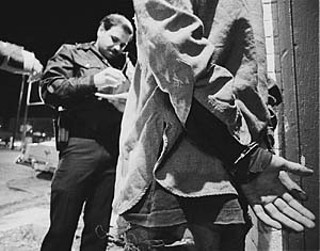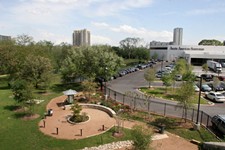Austin @ Large: Unequal Farce
The 'Statesman' leaps to Its own defense ... and crashes on takeoff
By Michael King, Fri., Feb. 13, 2004

Mike Clark-Madison is fully occupied elsewhere this week – see "Facing the South," p.28 – and he was kind enough to share this space, in order to follow a continuing city story. (Kindly address this week's angry letters to me.)
But before we take off the gloves again – first, an apology to our readers.
We screwed up, badly, when we reported last week that as part of its "Unequal Force" series, Jan. 25-28, the Austin American-Statesman had published mug shots of the 10 Austin police officers who have filed the most "Use of Force Reports." In singling out those 10 officers in its Jan. 27 segment, the daily published brief career summaries of each officer, but it did not publish their photos (except, on a different day, one of Detective Michael Olsen and of Officer Scott Glasgow). After staff writer Jordan Smith made the initial error (apparently picked up from e-mail broadsides, and overlooked by two editors), we compounded that mistake by repeating it in Editor Louis Black's quotation of the Smith passage in "Page Two." It was a foolish (and unfortunately repeated) mistake, and on Sunday the Statesman beat us up a couple of times for it – beatings we fully deserved.
We apologize to our readers – and to the editors, reporters, and staff of the Statesman – for that mistake in our report. When it was first pointed out to us last week by Statesman Managing Editor Fred Zipp, we corrected it on our Web site, again in the "Oops!" column today, and we hope this week's restatement helps to mitigate any future misrepresentation or confusion about that detail of the Statesman's coverage. We were wrong, it was nobody's fault but our own, and we apologize.
That said, however, the fact remains that the Statesman report has seriously misrepresented both the extent and implications of racial disparity in police uses of force – and that misrepresentation needs to be understood if the larger issues clumsily reflected in the current community screaming match are to be adequately addressed. It won't be addressed by mistaking the trees – the cops on the beat – for the forest: the institutional and political culture within which police officers (and indeed all of us) work. Our political institutions, top to bottom, are increasingly making street cops the first resort for virtually every social problem facing the city – from traffic gridlock to family welfare to substance abuse to emergency mental health – and then blaming the cops when the problem explodes in their faces. That's not right, that's not fair – and that does not address the real problems.
Painting by Numbers
So we do not apologize for publishing a strongly skeptical analysis of the Statesman series, and for strongly questioning its principal conclusion – repeated relentlessly since Jan. 25 – that (to quote ad nauseam Editor Rich Oppel) "The series demonstrated that from 1998-2003, African Americans were 100 percent more likely to be met with force than were whites in contact with police, while Hispanics were 25 percent more likely than whites to be subjected to force." This stark and headline-generating conclusion is "demonstrated" only if one accepts the extremely dubious statistical presumptions submerged in that phrase "in contact with police" or the Statesman's common variation, "encounters with police." The daily insists on comparing unevenly self-reported uses of force by officers with the entire universe of any and all reported police contacts with Austin citizens, however innocuous (although as we see below, that too is subject to arbitrary adjustment). Using those "encounters" as its base number is the only way the paper can arrive at its "100 percent" (i.e., twice as likely) figure for African-Americans and "25 percent" (i.e., 1.25 times as likely) for Hispanics in being subjected to police force.
Stung by the public criticism, on Sunday Statesman reporter Andy Alford, who co-wrote the series, finally explained and defended the paper's methodology (as was never done during the series itself). Alford says the reporters rejected APD Chief Stan Knee's argument that the comparison should include traffic stops – somewhat mysteriously, since aren't these also very common "encounters with police"? – because of the incompleteness of the data (surely no worse than the incompleteness of APD's inconsistently maintained use-of-force reports). Then Alford adds the accurate – but in this context irrelevant – recent independent report showing racial disparities in traffic-stop consent searches. What's at issue in the Statesman series, presumably, is not searches but racially disparate uses of force. Secondly, Alford argues that since witnesses and bystanders were sometimes subject to force, analyzing force only in connection with arrests would have been too narrow a scope. But 90% of the use-of-force reports involve arrests, and even the paper's anecdotal exception – the apparent assault by Detective Michael Olsen on bystander/witness Jeffrey Thornton, now subject to a lawsuit – in fact ended in an arrest, so statistically, that stays in the box. As Jordan Smith reported last week – in the absence of better data that does not currently exist – the most accurate base comparison for uses of force is against numbers of arrests (even though both numbers are also subject to qualification).
Alford points out that the approaches suggested by APD "still show disparities in how the police use force among various ethnic groups." That is true – as confirmed in the Chronicle last week, in a straightforward comparison of uses of force in arrest situations, which can at least be assumed to be roughly comparable for statistical purposes. And those comparisons do in fact show there is a racial disparity in police uses of force, as we also reported – although nowhere near the melodramatic ratio insisted upon by the Statesman (and the use-of-force rate against Hispanics, at least in this limited context, appears to be lower than that against whites).
The real problem, for the Statesman, is that those comparisons do not show the radical degree of racial disparity that generates alarmist numbers like "African Americans are 100 percent more likely to be met with force," and sensational headlines like "Blacks bear the brunt when police use force." Even on the Statesman's own terms, the latter headline, which opened the series on Jan. 25, is so misleading as to be untrue – for in plain English it says that "On those occasions when police use force, African-Americans are treated worse." That may or may not be true, but the Statesman statistics and stories have nothing to say about it, one way or another. (A more accurate but equally uninformative headline might read, "Most drunks busted downtown are white.")
Despite the elaborately packaged, pseudo-scientific, Rube Goldberg contraption of the Statesman's analysis that spits out the same numbers, over and over, the actual situation (based on available, highly qualified information) appears to be much less inflammatory: when placed under arrest, blacks are subject to force about 20% more often than whites, and Hispanics about 15% less often. What those real disparities may mean is uncertain (and Alford's Sunday explanations suddenly introduce resisting-arrest figures that would require much closer scrutiny). But certainly those statistics do not suggest, as the Statesman series unfortunately implies, that a small number of cowboy cops, throughout the city but primarily based Downtown, is beating up African-American citizens at will.
This misleading slipperiness of the Statesman's approach to the data is highlighted when Alford returns to the question of the Downtown cops. The paper did note in passing that these officers "primarily worked at night and downtown," but that phrasing de-emphasizes the fact that all 10 officers were assigned to the Downtown Area Command, which regularly patrols Sixth Street. Alford acknowledges that the use-of-force reports of the 10 officers show that "52 percent of the subjects were white" (i.e., almost exactly the percentage of whites in Austin). Significantly, Alford doesn't then follow that figure with the expected percentages of force used against minorities – presumably because they are roughly proportionate to the Austin population breakdown. Instead, she immediately shifts statistical ground, once again, to a comparison against all "encounters" – enabling her to reproduce the paper's now-reflexive, misleading percentages: "during encounters ... downtown police officers in general were 110 percent more likely to use force against African Americans ... [and] 26 percent more likely to use force on Hispanics."
If the very uncertain "reported encounter" numbers suggest anything, it appears to be a much more insidious but also much less sensational form of institutional racism. White people generally "encounter" police officers more often in friendly or nonthreatening situations, and too often cannot comprehend why minority citizens – from long experience – might view police with suspicion or even hostility. But that is not the same thing as "demonstrating" that Austin cops are using force on minority residents at a radically disproportionate level, as the Statesman continues to insist, but the available statistics simply do not show.
We repeat. "Use-of-force" numbers and "encounter" numbers are not readily comparable without significant adjustment, and abruptly sliding the latter into a discussion of the former is seriously misleading. It is also simply unfair to the officers who filled out the use-of-force reports in good faith that they wouldn't be used as self-justifying bludgeons against the officers involved. (That's not in any way to excuse Detective Olsen, who apparently not only physically abused a bystander but then lied about it to his superiors.) So while it's true that the Statesman didn't publish mug shots of the 10 officers, it did single them out in a statistical lineup for particular identification as suspect cops, based on an analysis that, in this form, simply doesn't sustain such a damning suspicion.
Oppel-Inania, Yet Again
In most circumstances, the Statesman normally bites its swollen tongue rather than condescend to mention the Chronicle, so we're rather amused that we've gotten the recently semiretired Rich Oppel off his complacent duff, huffing and puffing at our impudence and working for a living again (at least this week). Oppel was in high dudgeon about our "mug shots" mistake, and as embarrassed as we are to admit it, he's got us on that one – though it changes not a whit the substance of our critique. It's even more amusing to find him just now discovering a "culture of secrecy" at the APD, because the brass apparently misled him about officers' willingness to speak to reporters. How shocking – although predictably, Oppel uses the administration's stonewalling as an excuse to take a gratuitous and undeserved swipe at "the police union, the Austin Police Association." (Official Austin's "veneer of liberalism," as the ever illiberal Oppel puts it, is never so transparent as on the subject of unions.) We invite him to look over Jordan Smith's ongoing Chronicle coverage of the APD's dismal "Mala Sangre" history – not a subject in which his paper has deigned to invest much serious labor. (Hint: It won't fit readily on a spreadsheet.) If he did so, maybe he wouldn't be so surprised at the Fifth Floor's traditions of omerta.
Oppel dismisses Smith's careful analysis of "Unequal Force," his latest application for a Pulitzer, claiming Smith made "errors of fact repeatedly." Other than the phantom mug shots – mea maxima culpa – he cites only one: We used a figure APD gave us of 553,194 total arrests in the nearly five-year period covered by the series. Oppel says that his figure, confirmed with the APD, is 265,579, and that the Statesman reported it (although despite considerable searching and a direct request to Oppel, we could find that number nowhere in the series, nor indeed in the last six months of Statesman coverage). We again contacted APD, and spokesman Kevin Buchman profusely apologized for the department's mistake in supplying to Smith the 553,194 total as "total arrests" – that number, he says, actually includes "total arrests plus charges." The total arrest figure is about half that number (and about 10% higher than the number Oppel cited). But that's OK; let's use the number Oppel "confirmed" with APD.
As anyone who hasn't fallen in love with Microsoft Excel should understand, it makes no difference. Since the demographic breakdown of those two gross numbers is approximately the same, the comparison of the relative arrest rate and use-of-force rate between ethnic groups is unchanged. The same applies to Oppel's claim that Smith's figure on use-of-force reports is "off 30 percent." Oppel didn't clarify, and instead referred our follow-up query to reporters Alford and Erik Rodriguez, who say Smith didn't give the correct time frame for the number of use-of-force reports she directly analyzed. Smith disagrees. (As Smith's story makes clear, she analyzed reports from about three years, and the Statesman reporters used about five.)
But we don't care to pursue this war of the dueling databases, because again, even if we presume that Alford and Rodriguez are correct, the time frame has no effect on the relative demographic numbers. As Smith had already reported last fall in relation to the Scott Glasgow/Jessie Owens case, the use-of-force reports may be helpful in analyzing individual incidents, but they are quite unreliable for reaching broad conclusions.
Despite Oppel's condescending mystification and the Statesman's insistence, this is not a dispute about numbers, but about the interpretation of the numbers. Alford and Rodriguez continue to believe, as they put it, "there's nothing random about the [use-of-force] rate we calculated. Rather, it's a calculation from documented [APD-reported] events, and it shows the likelihood of encountering force, broken down by race, in that universe of events." Unfortunately, that "universe of events" bears no real relationship to the use-of-force data, and the calculations – however accurately digitized -- that attempt to establish direct connections between them collapse of their own weight.
Or as Oppel himself might put it, "With erroneous building blocks such as that, all claims built upon them fail as well."
The Statesman's readers, the APD, and the entire city deserve an apology. We won't hold our breath. ![]()
Got something to say? The Chronicle welcomes opinion pieces on any topic from the community. Submit yours now at austinchronicle.com/opinion.








